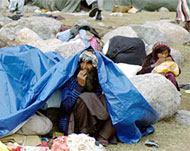‘Thermal’ tents offer hope to quake-hit
Tested in cold storage and wind tunnels, successfully used in the Kosovo crisis, a cheap shelter quickly assembled from local materials offers hope for some of the more than two million homeless facing a bitter winter in wake of South Asia’s earthquake, aid workers say.

“It is not exactly central heating, but it will stop most of the cold,” says Aditi Kapoor of the aid group Oxfam, describing a “thermal shelter” ready for replication in quake-ravaged regions of Indian- and Pakistani-administered Kashmir.
Measuring 12 by 12ft (3.6m), the semi-spherical tent is made of thick plastic laid over a frame of standard water pipes and lined with ordinary blankets. Mud is banked up around the shelter to prevent water from seeping inside and a simple drain pipe can be laid under it for sanitation.
The shape offers less resistance to strong winds and allows snow to slide easily off the top, Kapoor said.
Inside, extra warmth can come from a bukhari, a simple, traditional stove, and a kangri, the small coal burner that Kashmiris slip under their robes in winter. Both emit smoke but no flames.
Compared to conditions under which most of the survivors now live, the shelter seems almost tropical.
Under the stars
Their houses totally razed or too dangerously unhinged by the earthquake to live in, victims now spend nights huddled in non-insulated tents, makeshift shelters made of maize stalks or under the stars.
 |
|
Many of the quake-hit manage |
“The cold is setting in very fast. It is critical to have an alternative shelter for people. It will save lives because it will save them from the cold,” Kapoor said.
Many of the shelters – Oxfam’s or other versions that may materialise – will have to be supplied locally as aid officials say that not enough winterised tents can be shipped in time from aid warehouses or private contractors worldwide.
“Such initiatives have a huge advantage. We pick up material from the local market and in three hours it is up,” says Sarabjit Singh Sahota, an Indian architect who adapted the prototype for use on the Indian subcontinent.
Oxfam is also working on the shelter project in Pakistan.
Three people, or two strong men, can assemble the shelter, which costs a maximum of 7000 rupees ($158).
Funds
Oxfam is ready to provide funds for those who cannot afford to buy one, or victims can use some of the 40,000 rupees the Indian government began giving out this week to homeless families.
|
“If we are not able to provide such shelters by the end of November, there will be great hardship for people” Sarabjit Singh Sahota, |
“We will try to build huts, but tents will be fine as long as they are able to resist rainfall and the snow,” said Shabir Ahdmir, whose house was devastated along with all the other 296 in the village of Jabla.
The shelter prototype was developed in 1999 by an England-based group, Shelter Project, which conducted tests in cold storage warehouses, car factory wind tunnels, Britain‘s open fields and via computer modelling.
Oxfam United Kingdom deployed the shelters in Kosovo and they were modified in India, where the aid group put up a model on the grounds of the Srinagar Youth Hostel and gave demonstrations to villagers, other aid agencies and the government receiving what Kapoor says was a very positive response.
Now, the challenge is to have as many up as soon as possible.
“If we are not able to provide such shelters by the end of November, there will be great hardship for people,” Sahota said.